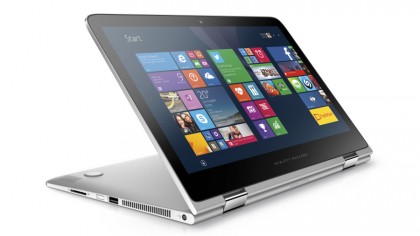A glimpse of the future: what we can expect from Windows 10 PCs
The low down on how the personal computer is evolving in 2015
Now that Windows Phone won't be a separate OS any more, there are more phone-like features going into Windows 10. Windows 8.1 already supports Bluetooth LE for things like low power keyboards and even wearable devices like the Fitbit. That's still in Windows 10, but there's also an SMS router and "Host card emulation for NFC payments". That's the same technology that Google just bought Softcard for, letting you tap with your phone – or your tablet – to make a payment.
That session also covers "proximity features" – Microsoft has often talked about using NFC in a tablet or PC keyboard to make it easier to pair peripherals or to let you send content you're viewing on one device to another, like switching video from your phone to your TV when you get home.
Phones are also one of the reasons Windows 10 will support new sensors in addition to the usual accelerometers, ambient light sensors, compasses, gyroscopes and so on. These 'new' sensors are already used in phones and the OEMs need them.
At least one Windows Phone device (the Lumia 1020) has a barometer in – although Windows Phone 8 doesn't let developers use it – and several Samsung and Nexus handsets also have barometers in, and they're common in GPS devices. They're not for weather purposes, though – knowing the atmospheric pressure is a good way of checking the altitude and that speeds up getting your GPS location. That saves power because you can turn off the high power GPS radio more quickly, and it will work in Windows 10.
Similarly, supporting long range proximity sensors is key for phones – it's how the phone knows to turn off the screen when you're holding it up to your ear, so the side of your face doesn't activate the touchscreen and hang up your call. You could also use them to turn on an NFC sensor only when there was something near it to read, which might also save power.
Windows 10 also supports custom and composite sensors. In the past PC makers could build in any sensor if they wanted to write the driver for it themselves, but making that easier is important for Internet of Things devices that need a much wider range of sensors.
Low hardware requirements
Microsoft is also keen to attract OEMs who've previously made devices using Android or Chrome OS and other operating systems, promising them that "you can reuse many of your existing designs from other platforms on Windows". Supporting more sensors will help OEMs build Windows devices more quickly, and it suggests that the hardware requirements for Windows 10 PCs will be pretty low.
Sign up to the TechRadar Pro newsletter to get all the top news, opinion, features and guidance your business needs to succeed!
That fits with what OEMs have asked Microsoft for – to let them use the same systems they might otherwise put Android on, and it means the flood of cheap Windows tablets should continue. But that does also mean they might miss out on some Windows 10 security features.

We already know security is a major area for Windows 10, and it makes sense that Microsoft will be pushing OEMs to put TPMs in Windows 10 PCs because new features like FIDO-compliant next-generation credentials and enterprise lockdown won't work without them.
Back in 2013, Microsoft said that by January 2015 all PCs would have to have a Trusted Platform Module to get a Windows logo. But that requirement went away last year, probably as part of the 'Bing for Windows' licence deal – OEMs making cheap Windows tablets don't want to spend the few extra dollars to add a TPM, so some 8-inch Windows tablets have a TPM, but others don't.
The Windows Hardware Certification documents currently say "Systems that support Connected Standby must also have a TPM". Microsoft can't tell PC makers they can reuse the same hardware they bought to make Intel-based Android tablets (which don't use the TPM) and then make them have a TPM in every PC. But it can push the idea by pointing out that you need them for password replacements – especially on tablets people will take to work, for mobile payments using that NFC support, and for streaming copy-protected ultra-high definition content.
After all, what Microsoft wants – and will be pushing at WinHEC – is not just lots of PCs at low prices, but a wide range of PCs from cheap tablets to high-end systems with features you can't get in Macs or Chromebooks.
- Read more about Windows 10 migration on our sister website, ITProPortal.com
Mary (Twitter, Google+, website) started her career at Future Publishing, saw the AOL meltdown first hand the first time around when she ran the AOL UK computing channel, and she's been a freelance tech writer for over a decade. She's used every version of Windows and Office released, and every smartphone too, but she's still looking for the perfect tablet. Yes, she really does have USB earrings.